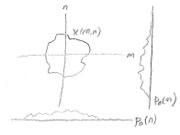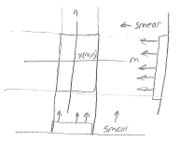| Line 1: | Line 1: | ||
<br> | <br> | ||
| + | <center> | ||
| + | <font size="4"> [[ECE_PhD_Qualifying_Exams|ECE Ph.D. Qualifying Exam]] </font> | ||
| − | = | + | <font size="4"> Communication Networks Signal and Image processing (CS) </font> |
| − | + | ||
| − | + | ||
| + | <font size="4"> [[QE637_sol2013|Question 5, August 2013(Published on May 2017)]],</font> | ||
| + | |||
| + | <font size="4">[[ QE637_sol2013_Q1 | Problem 1]],[[ QE637_sol2013_Q2 |2]]</font> | ||
| + | </center> | ||
---- | ---- | ||
Revision as of 21:07, 1 May 2017
Communication Networks Signal and Image processing (CS)
Question 5, August 2013(Published on May 2017),
Problem 1,2
Solution 1:
a) $ {{P}_{0}}({{e}^{j\omega }})=\sum\limits_{n=-\infty }^{\infty }{{{p}_{0}}(n){{e}^{-jn\omega }}}=\sum\limits_{n=-\infty }^{\infty }{\left( \sum\limits_{m=-\infty }^{\infty }{x(m,n)} \right){{e}^{-jn\omega }}}=\sum\limits_{m=-\infty }^{\infty }{\sum\limits_{n=-\infty }^{\infty }{x(m,n)}{{e}^{-j(m0+n\omega )}}=X({{e}^{j0}},{{e}^{j\omega }})} $
b) $ {{P}_{1}}({{e}^{j\omega }})=\sum\limits_{m=-\infty }^{\infty }{{{p}_{1}}(m){{e}^{-jm\omega }}}=\sum\limits_{m=-\infty }^{\infty }{\left( \sum\limits_{n=-\infty }^{\infty }{x(m,n)} \right){{e}^{-jm\omega }}}=\sum\limits_{m=-\infty }^{\infty }{\sum\limits_{n=-\infty }^{\infty }{x(m,n)}{{e}^{-j(m\omega +n0)}}=X({{e}^{j\omega }},{{e}^{j0}})} $
The solution used $ v $ and $ \mu $ to represent frequency axis. It used $ w $ to subuslitude both $ v $ and $ \mu $ which is confusing. The solution should stated let $ w=v $ and $ w=\mu $ at (a) and (b).
c)
$ \sum\limits_{n=-\infty }^{\infty }{{{p}_{0}}(n)}==\sum\limits_{n=-\infty }^{\infty }{\left( \sum\limits_{m=-\infty }^{\infty }{x(m,n)} \right)}=\sum\limits_{m=-\infty }^{\infty }{\sum\limits_{n=-\infty }^{\infty }{x(m,n)}{{e}^{-j(m0+n0)}}=X({{e}^{j0}},{{e}^{j0}})} $
d) No, they don’t. From part (a) and (b), we know that $ {{P}_{0}}({{e}^{jw}}) $ and $ {{P}_{1}}({{e}^{jw}}) $ represent the horizontal and vertical axes of the 2D DSFT $ X({{e}^{j\mu }},{{e}^{j\upsilon }}) $, which is not enough for reconstruction of x(m, n). For example, $ {{x}_{1}}(m,n)=\left( \begin{matrix} 1 & 3 \\ 2 & 4 \\ \end{matrix} \right),_{{}}^{{}}and_{{}}^{{}}{{x}_{2}}(m,n)=\left( \begin{matrix} 0 & 4 \\ 3 & 3 \\ \end{matrix} \right) $ have the same $ {{p}_{0}}(n)=\left[ \begin{matrix} 3 & 7 \\ \end{matrix} \right]_{{}}^{{}}and_{{}}^{{}}{{p}_{1}}(m)=\left[ \begin{matrix} 4 \\ 6 \\ \end{matrix} \right] $. So, x(m,n) can’t be reconstructed from $ {{p}_{0}}(n)=\left[ \begin{matrix} 3 & 7 \\ \end{matrix} \right]_{{}}^{{}}and_{{}}^{{}}{{p}_{1}}(m)=\left[ \begin{matrix} 4 \\ 6 \\ \end{matrix} \right] $.
Solution 2:
a) $ {{P}_{0}}({{e}^{j\omega }})=\sum\limits_{n=-\infty }^{\infty }{\sum\limits_{m=-\infty }^{\infty }{x(m,n)} {{e}^{-jn\omega }}}=X({{e}^{j0}},{{e}^{j\omega }}) $
b) $ {{P}_{1}}({{e}^{j\omega }})=\sum\limits_{m=-\infty }^{\infty }{\sum\limits_{n=-\infty }^{\infty }{x(m,n)}{{e}^{-jm\omega }}}=X({{e}^{j\omega }},{{e}^{j0}}) $
To be consistent with the problem statement, frequency notation$ \mu $ corresponds to the spatial notation $ m $ and is the first parameter. As a result, the solution of the (a) and (b) can be switched.
c) They do not; $ {{p}_{0}}(n)\ and\ {{p}_{1}}(m) $ are projections at two angles, and do not contain enough information to reconstruct x(m,n).
$ \begin{align} & X({{e}^{j\mu }},{{e}^{j\upsilon }})=\sum\limits_{m=-\infty }^{\infty }{\left[ \sum\limits_{n=-\infty }^{\infty }{x(m,n)} \right]}{{e}^{-jm\mu }}{{e}^{-jn\upsilon }} \\ & X({{e}^{j\mu }},{{e}^{j\upsilon }})\ne \sum\limits_{m=-\infty }^{\infty }{{{p}_{1}}(m)}{{e}^{-jm\mu }}{{e}^{-jn\upsilon }}\ne {{P}_{1}}({{e}^{j\mu }}){{e}^{-jn\upsilon }} \\ & \Rightarrow Can't\ do\ it! \end{align} $
- To form reconstruction, need projections along many angles.
- Could reconstruct a very simple object, like triangle.
Therefore, P0 and P1 will be the same for X0 and X1. We will not be able to recover x0 and x1 based on P0 and P1.
Related Problem
1.Let g(x,y) = s'i'n'c(x / 2,y / 2), and let <span class="texhtml" />s(m,n) = g('T,n'T) where T = 1.
a) Calculate G(μ,ν) the CSFT of g(x,y).
b) Calculate S(ejμ,ejν) the DSFT of s(m,n).
2. Assume that we know (or can measure) the function
$ p(x) = \int_{-\infty}^{\infty}f(x,y)dy $
Using the definitions of the Fourier transform, derive an expressoin for F(u,0) in terms of the function p(x).
(Refer to ECE637 2008 Exam1 Problem2.)



